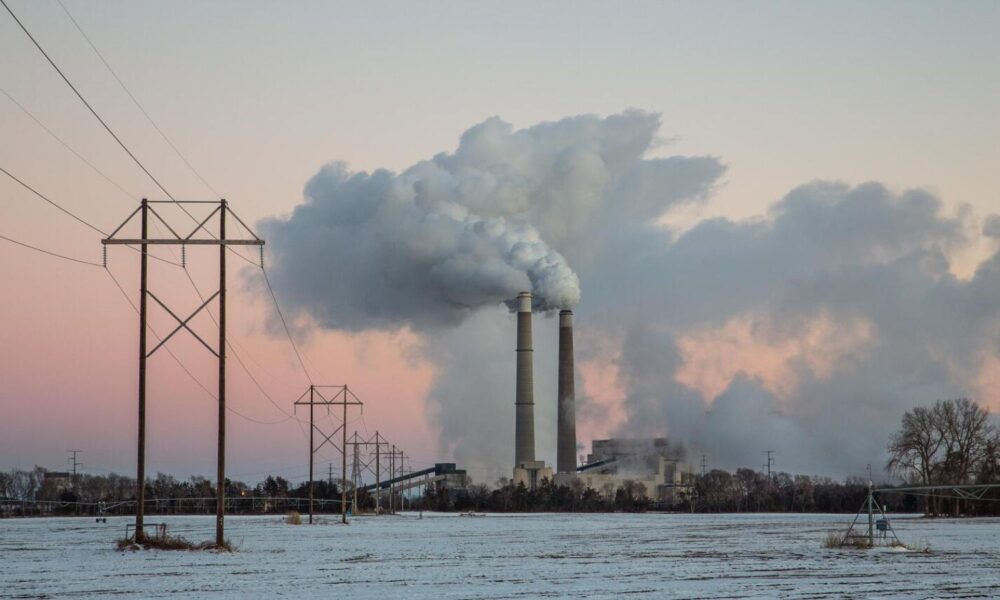
The U.S. Environmental Protection Agency (EPA) has introduced new regulations to reduce CO2 emissions from fossil fuel power plants. These rules target coal-fired plants and new natural gas facilities, aiming to push the industry toward cleaner operations. However, experts argue that failing to regulate existing gas plants limits the full potential of these reforms.
>> RELATED: Senators Seek Answers on EPA Effort to Claw Back $20 Billion in Climate Funds

How the New EPA Rules Work
The regulations require coal plants to either install carbon capture and storage (CCS) technology by 2032 or shift to natural gas co-firing by 2030, depending on their retirement plans. New natural gas plants operating as baseload power sources must also equip CCS by 2032.
However, existing natural gas plants are exempt from these strict requirements. Without regulations on older gas plants, the rules miss a major source of emissions, allowing inefficient facilities to continue polluting without major upgrades.
The Missed Potential for Greater Reductions
A study published in One Earth suggests that while the EPA’s rules could halve power sector emissions by 2040, they leave room for more reductions. Research from Princeton University’s ZERO Lab finds that regulating both new and existing gas plants under the same standards could significantly lower emissions at a lower cost per ton of CO2 avoided.
Jesse D. Jenkins, who leads Princeton’s ZERO Lab, highlighted this concern in a policy briefing: “The EPA’s current approach accelerates coal retirements but leaves a major loophole by not addressing existing gas plants, which could result in prolonged emissions.” The report stresses that without consistent regulations, existing gas plants will continue to be a major emissions source, undermining the full impact of the rules.

>> In Other News: Alberta Set to Build World's First Full-Sized Zero Carbon Cement Plant
Coal Plant Retirements Lead the Way
One of the biggest sources of emissions reductions under the new rules is the accelerated retirement of coal-fired power plants. Coal has been declining due to economic pressures, environmental policies, and the growth of renewables. The EPA’s stricter regulations will likely drive more shutdowns, further slashing emissions.
But if existing gas plants take the place of retired coal plants without stringent emissions controls, the gains could be offset. The lack of regulations for these plants could slow progress toward U.S. climate goals.
The Political Landscape and Uncertain Future
The battle over emissions rules is far from over. The EPA first attempted to regulate power plant emissions in 2014 under the Clean Power Plan (CPP), but the Supreme Court struck it down in 2022, ruling that the agency exceeded its authority.
In response, the Biden administration adopted a more targeted approach, setting plant-specific emission standards rather than broad, sector-wide limits. However, policy shifts remain a constant threat. Shortly after taking office in 2025, President Donald Trump ordered a review of the EPA’s new rules, raising concerns about possible rollbacks.
Qian Luo, co-author of the One Earth study, emphasized the risks of inconsistent policies, stating in a policy report: “A lack of stable, long-term policy frameworks discourages investment in clean energy solutions, slowing progress on emissions reductions.”
Strengthening the Rules for Maximum Impact
To ensure deeper and more cost-effective emissions cuts, experts suggest the following improvements to the EPA’s rules:
1. Regulate Existing Natural Gas Plants
Setting equal emission standards for all gas plants, regardless of age, would prevent inefficient plants from prolonging their lifespan.
2. Expand Incentives for Carbon Capture and Clean Energy
Additional funding and stronger incentives for CCS, renewables, and grid storage could accelerate the shift away from fossil fuels.
3. Ensure Long-Term Policy Stability
Avoiding constant regulatory changes would give companies confidence to invest in low-carbon technologies rather than delaying decisions.
The Bottom Line
The EPA’s 2024 power plant rules mark progress, but without including existing gas plants, they fall short of their full potential. By closing this gap, the U.S. could take a more effective and cost-efficient path toward cutting emissions, ensuring that all fossil fuel power plants are held to the same standard in the push for cleaner energy.
Subscribe to the newsletter
Daily decarbonization data and news delivered to your inbox
Follow the money flow of climate, technology, and energy investments to uncover new opportunities and jobs.
Latest issues
-
How 45Q Credits Revived This Troubled $9B Megaproject
Inside This Issue 💰 How 45Q Credits Revived This Troubled $9B Megaproject 🍁 Commencement of First Phase Operations for a Carbon Capture and Storage (CCS) Project in Canada 🤝 Haffner Energy Secures...
-
The Deal Structure Everyone's About to Copy
Inside This Issue 💼 The Deal Structure Everyone's About to Copy 📈 Exxonmobil Raises Its 2030 Plan – Transformation Delivering Higher Earnings, Stronger Cash Flow, and Greater Returns ⚡ Nextera Wor...
-
Inside XCF Global's $300M Bet to Double U.S. SAF Output
Inside This Issue ✈️ Inside XCF Global's $300M Bet to Double U.S. SAF Output ⚙️ Capsol Technologies Signs MoU with US Utility to Deploy CapsolGT® for Low-carbon Gas Power Generation 🏭 Babcock &...
Company Announcements
-
Clean Planet Technologies (CPTech), part of the Clean Planet Group, has announced that its core pyrolysis-oil upgrading process has now been formally patented in both the United States and Saudi Ar...
-
(December 12, 2025 - Oslo, Norway) Nel ASA (Nel, OSE: NEL) is pleased to announce that following a seven-year development program, and now a successful start-up and production of clean hydrogen on ...
-
Hydrogen Technology Venture Launches in Bowling Green
BOWLING GREEN, Ky. — A new tech company is coming to Bowling Green, bringing dozens of jobs to Warren County. What You Need To Know UFS ARK will be a joint venture of United Fiber Sensing and OgM...
-
HyOrc Positions Green Methanol as the Economic Solution to Shipping’s Decarbonization Challenge
HOUSTON, Dec. 12, 2025 (GLOBE NEWSWIRE) -- HyOrc Corporation (OTCID: HYOR), a fully SEC-reporting clean-energy company focused on decarbonizing heavy industry, today commented on the growing global...